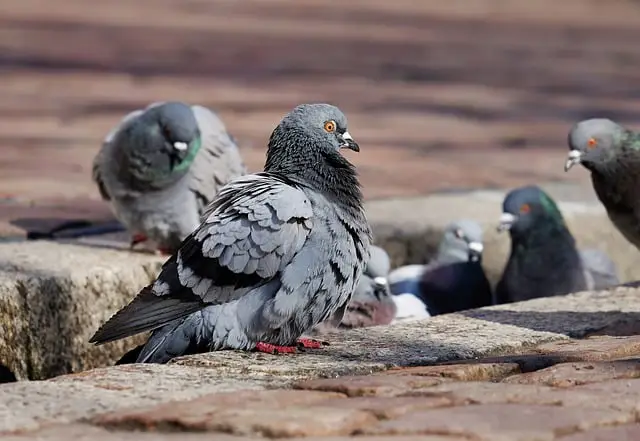Pigeons, often known as ‘rats with wings’, are a common sight in cities around the world. Their constant cooing, mess they leave behind, and potential health risks they pose have made them less of an admired bird species and more of an urban nuisance. But why is pigeon control so crucial, and how can we implement it effectively?

The need for pigeon control extends beyond mere aesthetics or noise disturbances. Pigeon droppings can cause significant property damage, accelerating the deterioration of buildings and monuments due to their acidic nature. Moreover, pigeons are known carriers of various diseases such as histoplasmosis and salmonella, posing a serious public health risk.
So, how can we effectively control pigeons, deal with infestations and prevent future occurrences?
First, Understand Pigeon Behaviour
Understanding pigeon behavior is the first crucial step towards effective pigeon management.
As highly adaptable birds, pigeons have an uncanny ability to live and breed in a variety of environments, predominantly urban areas. Their diet is highly versatile, making it easy for them to survive on human scraps.
They also have a homing instinct and are monogamous, often choosing one mate for life and preferring to stay in a single location, where they breed several times a year. Each breeding cycle results in two eggs, which means their populations can rapidly increase if left unchecked.
They’re also remarkably resistant to common diseases that would decimate other bird populations, contributing to their pervasive presence
Preventive Measures for Pigeon Control
Prevention is always better than cure, especially when it comes to pigeon control. By making our spaces less hospitable to these birds, we can deter them from settling in the first place.
One of the primary preventive measures is ensuring cleanliness and proper sanitation. Pigeons thrive where food and water are readily available. By securing garbage bins, cleaning up food scraps immediately, and removing standing water, we can minimize these resources and make the area less attractive to them.
Structural modifications can also make habitats less appealing or accessible. Pigeons prefer ledges, roof spaces, and other flat surfaces for nesting. Installing bird spikes, netting, or sloped surfaces can prevent pigeons from finding suitable nesting locations.
Birth control, one of the most effective pigeon control solutions by OvoControl, is also worth considering as part of an integrated pigeon management plan.
OvoControl, a type of pigeon birth control, works by interfering with egg development, reducing the number of hatching eggs and thereby controlling the population growth. It is a humane and non-lethal solution that effectively reduces pigeon populations over time. The product is simply mixed with food and fed to pigeons daily. Since it’s species-specific, it does not harm other birds or wildlife.
Pigeon Deterrents: Making Your Property Unappealing
Even with preventive measures in place, it’s possible to still find some pigeons exploring your property. This is where deterrents come into play. Pigeon deterrents are designed to make your property less appealing to pigeons without causing them harm.
These include:
- Physical deterrents (including bird spikes, netting, or electric tracks). These devices create physical barriers that prevent pigeons from landing or nesting. Bird spikes, for example, are not designed to harm pigeons but to take away the flat surfaces they prefer for roosting.
- Visual scares like reflective tapes, predator decoys, or laser devices are designed to frighten pigeons away. Pigeons, like many birds, are easily scared by shiny objects, sudden movements, or perceived predators.
- Sound devices use distress calls or predator sounds to create an environment that pigeons perceive as dangerous. These need to be used judiciously, though, as they can also be disruptive to other wildlife.
- Taste aversions are non-toxic substances applied to surfaces where pigeons roost or feed. They give off a taste or sensation that irritates pigeons, encouraging them to seek out other areas.
Pigeon Removal: Ethical and Effective Methods
Despite preventive measures and deterrents, pigeon infestations can sometimes still occur. In such cases, pigeon removal becomes necessary. However, it’s important to approach this process ethically and in accordance with local wildlife laws and regulations.
One of the most common pigeon removal techniques is trapping. This involves using a baited trap to catch pigeons, which are then relocated to a more suitable environment. Traps must be checked daily to ensure the wellbeing of the captured birds.
Another approach involves the use of birds of prey. Some professional pigeon control services use trained falcons or hawks to deter pigeons and encourage them to seek safer locations. However, this method requires specialist knowledge and is typically performed by licensed professionals.
Maintaining a Pigeon-Free Environment
Once you have effectively controlled the pigeon population and removed any remaining pigeons, the work isn’t over. Maintenance is a crucial part of any pigeon control strategy, ensuring that your efforts are long-lasting and that pigeons don’t return.
Regular inspection is key. Keep an eye out for signs of pigeon activity, such as droppings, feathers, or nesting materials. Inspect both easily accessible areas and hidden nooks and crannies, as pigeons can nest in small, out-of-the-way places.
Continued use of deterrents is also recommended. Even if the pigeon population has been reduced or eliminated, new pigeons may discover the location and try to settle. Keeping deterrents in place can discourage these newcomers and help maintain a pigeon-free environment.
Sanitation remains crucial even after pigeon removal. Remember that pigeons, as well as other pests, are attracted to easily available food and water. Continue to clean up food waste promptly, secure garbage bins, and remove standing water where possible.
